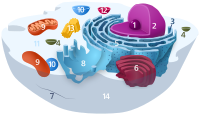
Photo from wikipedia
Abstract Natural evolution offers woods with intriguing multicomponent and anisotropic cellular structures, and endows super physicochemical properties. In order to compete with natural woods, many types of artificial woods were… Click to show full abstract
Abstract Natural evolution offers woods with intriguing multicomponent and anisotropic cellular structures, and endows super physicochemical properties. In order to compete with natural woods, many types of artificial woods were endeavored from polymers to achieve on-demand structures and functionalities. In most cases, production of oriented channels in mimic of wood lumina relied on a delicate unidirectional freeze-drying approach and utilization of volatile solvents. Herein we showed that artificial woods with controllable channel orientation could be produced from polymers in involatile solvents without particular control of freezing parameters. By dissolving cellulose in ionic liquid, oriented channels (diameter of 250—540 μm) were produced through diffusion-induced phase separation and strengthened through a facile freezing and air-drying process. The compressive strength could reach 5.5 MPa at the strain of 15% along the channel direction. With the presence of structural anisotropy, incorporation of low-dimension nanomaterials offered the design flexibility in adding super properties in mechanics, water transportation, solar-thermal effect, thermal and photo conductance. For example, artificial hybrid woods with carbon nanotubes showed super solar-thermal property. When combining with the water-transporting ability of oriented channels, it was promising to design an efficient solar-thermal evaporator (5.88 kg m-2 h-1 under equivalent 3-sun irradiation). Thus, this study not only suggests an unprecedented approach of producing artificial woods from polymers in involatile solvents, but also offers the flexibility of designing microstructures and functionalities of artificial woods for various applications.
Journal Title: Chemical Engineering Journal
Year Published: 2022
Link to full text (if available)
Share on Social Media: Sign Up to like & get
recommendations!